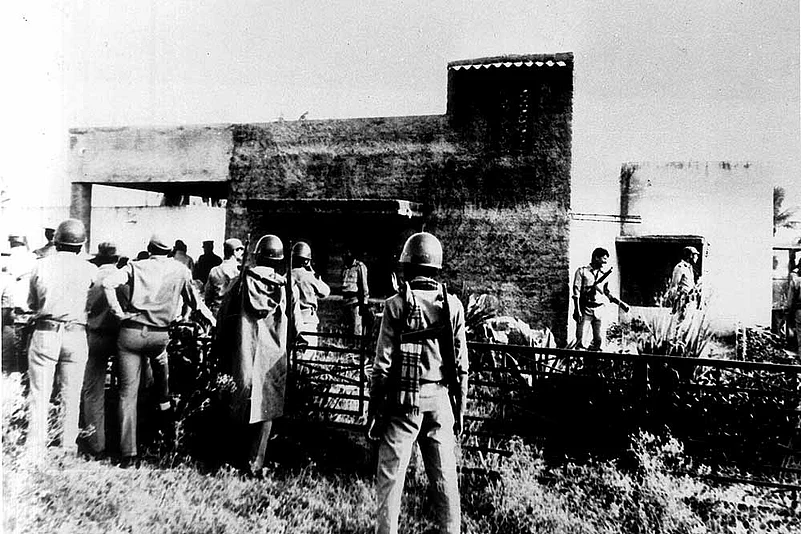The intrigue never ends in what’s probably India’s most sensational crime, though 25 years have gone by. Reams of paper, from inquiry commissions to books by investigators, journalists and politicians and movie scripts have discussed various facets of Rajiv Gandhi’s assassination—conspiracy theories, loose ends, botched operations and all. And, now, a narrative by Nalini Sriharan (Murugan) from her prison cell about her life, the interrogation, her daughter, the meeting with Priyanka Gandhi and also, in passing, the one question that has been debated endlessly: couldn’t Sivarasan, the ‘one-eyed Jack’, have been captured alive?
Like all sensational assassinations, questions still abound with every new commentary on that tumultuous period in 1991, and there have been quite a few in these intervening years. To recap, in 1998, seven years after the assassination, all the 26 accused persons apprehended by the Central Bureau of Investigation were sentenced to death. Subsequently, in appeal, the Supreme Court upheld the death sentence of four of them, including Nalini and her husband Murugan (as he’s known in case records), while commuting the sentences of three others. In the long chain of events in the years since, the sentences of those on death row were commuted. In recent years, there have been several legal petitions by the convicts, who have now spent 25 years in prison, seeking remission of their sentences. And it goes without saying that the convicts’ cause has been intertwined with Tamil Nadu politics, though, as some observers would argue, it has not been significant electorally.
“There is a lot of literature available on this, the latest one being Nalini’s. But where the truth begins or ends is unclear on all aspects of the issue,” says political commentator N. Sathiyamoorthy. “The first of the publications appeared within months of the assassination, which said Sivarasan did not belong to the LTTE,” he says. “These are aspects we should assume the CBI has gone into and produced before the court. We have to put a stop to the speculation at some point,” he reckons.
Obviously, the difficulty is about looking back at controversies that have erupted in all these years, particularly after the Jain Commission’s report in 1998, which probed possible conspiracy angles, including larger international ones. Former intelligence expert B. Raman wrote about the aftermath of the Jain Commission’s inquiry in his book The Kaoboys of R&AW—Down Memory Lane, thus: “As had happened during the inquiry into the assassination of Indira Gandhi, the inquiry into the assassination of Rajiv Gandhi too planted many needles of suspicion, without being able to remove any of the suspicions. Without throwing light to remove the areas of darkness surrounding the two tragic assassinations, the two inquiries only added to the darkness.”

The bodies of Sivarasan and Subha, August 20, 1991
In 2009, the Madras High Court was scathing in its observations about a habeas corpus petition by E. Veluchamy, a Congressman who had also deposed before the commission, seeking the release of the convicts on various grounds. It had dismissed the petition, calling it a frivolous litigation aimed at publicity and to settle political and personal scores.
To be sure, the tangled mass of these charges, allegations and mysteries has been something several writers have discussed. “I would want some insider to come out and actually tell us. I strongly believe there is enough material to actually unravel the conspiracy, particularly now that Sri Lanka is supposedly no more so inimical to the Tamils,” says journalist Faraz Ahmed, whose book, Assassination of Rajiv Gandhi: An Inside Job?, was published in 2014. “Everyone agrees there was naturally a conspiracy to kill Rajiv Gandhi. There’s no disagreement on this point between any of us who have written or with the police or various judgements that have come,” he says. “One thing I’m certain of is that it had to do with certain interests right here in India. That has been my contention in my book,” says Ahmed. The MDMA, he says, has been there for decades and “has done nothing”, referring to the Multi Disciplinary Monitoring Agency, a probe team that had been set up after the Jain Commission report.
K. Ragothaman, who was the chief investigating officer of the CBI’s special investigation team which probed the assassination, tells Outlook that there had been no laxity in tracking the mastermind of the assassination plot, Sivarasan. But he agrees that the final operation in Bangalore to nab him, which failed when Sivarasan, along with his six accomplices, committed suicide, was a setback because important documents had been destroyed by the gang before they died. “There was a special team formed to trace Sivarasan and Subha and it was on duty 24 hours along with NSG commandos. There was no laxity in trying to trace him,” says Ragothaman, whose book Conspiracy to Kill Rajiv: From CBI Files also caused a flutter when it was published in 2012, especially since he revealed in it that he wasn’t aware—during the investigation—of a video footage of Rajiv’s fateful rally at Sriperumbudur, though it had been available with intelligence agencies. “As far as the case is concerned, the killer is caught and punished. The main conspirator also died but who were behind the conspirator to instigate this? That is still to be unearthed, there is no question about this,” says Ragothaman.
















